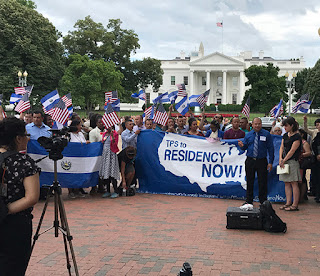Monday, March 11, 2019
TPS Detailed
The detailed statistical information on the US Temporary Protected Status (TPS) populations
from El Salvador, Honduras, and Haiti.
TPS can be granted to noncitizens from designated nations who are unable to return to their countries because of armed conflict, environmental disaster, or other extraordinary and temporary conditions. In January 2017, an estimated 325,000 migrants from 13 TPS-designated countries resided in the United States. This statistical portrait of TPS beneficiaries from El Salvador, Honduras, and Haiti reveals hardworking populations with strong family and other ties to the United States. In addition, high percentages have lived in the United States for 20 years or more, arrived as children, and have US citizen children.
The finds:
•The labor force participation rate of the TPS population from the three nations ranges from 81 to 88 percent, which is well above the rate for the total US population (63 percent) and the foreign-born population (66 percent).
•The five leading industries in which TPS beneficiaries from these countries work are: construction (51,700), restaurants and other food services (32,400), landscaping services (15,800), child day care services (10,000), and grocery stores (9,200).
•TPS recipients from these countries live in 206,000 households: 61,100 of these households (roughly 30 percent) have mortgages.
•About 68,000, or 22 percent, of the TPS population from these nations arrived as children under the age of 16.
•TPS beneficiaries from these nations have an estimated 273,000 US citizen children (born in the United States).
•Ten percent of El Salvadoran, nine percent of the Haitian, and six percent of the Honduran TPS beneficiaries are married to a legal resident.
•More than one-half of El Salvadoran and Honduran, and 16 percent of the Haitian TPS beneficiaries have resided in the United States for 20 years or more.
•The six US states with the largest TPS populations from these countries are California (55,000), Texas (45,000), Florida (45,000), New York (26,000), Virginia (24,000), and Maryland (23,000).
•Eighty-seven percent of the TPS population from these countries speaks at least some English, and slightly over one-half speak English well, very well, or only English.
•About 27,000, or 11 percent, of those in the labor force are self-employed, having created jobs for themselves and likely for others as well.
TPS status should be extended until beneficiaries can safely return home and can successfully reintegrate into their home communities. Most long-term TPS recipients should be afforded a path to lawful permanent resident (LPR) status and ultimately to US citizenship.
Subscribe to:
Post Comments (Atom)

No comments:
Post a Comment